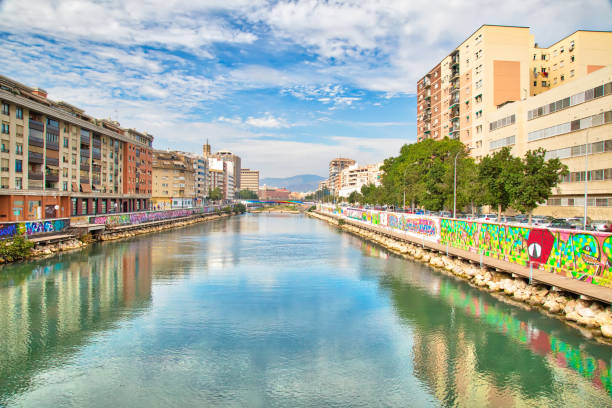Just a short drive from the lively streets of Malaga, you’ll find a refreshing escape: the Montes de Malaga Natural Park. It’s a place where the city’s hustle and bustle fade away, replaced by the gentle rustling of pine trees and the distant murmur of the Guadalmedina River. This isn’t just a park; it’s a slice of Andalusian paradise, rich in history and teeming with life. Whether you’re a local seeking a weekend getaway or a traveler looking for hidden gems, this park offers a chance to reconnect with nature and take a breather from the modern world. Let’s dive in and discover what makes this place so special.


Carlos Ramirez
Carlos Ramirez is a native of Malaga and a passionate advocate for the natural wonders of Andalusia. Growing up on the fringes of the Montes de Malaga Natural Park, he developed a deep love for its landscapes, wildlife, and history. Carlos has spent over a decade exploring every nook and cranny of the park, making him one of its most knowledgeable enthusiasts. When he’s not hiking its trails or documenting its beauty through photography, Carlos writes extensively about the park, hoping to inspire others to cherish and protect this Andalusian treasure. With a background in environmental science and a flair for storytelling, his writings offer a unique blend of personal anecdotes, factual insights, and captivating narratives.
The Heartbeat of Malaga – The Guadalmedina River
The Guadalmedina River, whose name is derived from the Arabic term “وادي المدينة” (wādī l-madīna), meaning ‘river of the city’, has been an integral part of Malaga’s landscape and history. This river, which gracefully courses through the city, has not only shaped its geographical contours but has also played a pivotal role in its socio-cultural evolution.


Historical Significance
Historically, the Guadalmedina has been a silent witness to the rise and fall of civilizations in Malaga. It has seen the city grow, evolve, and transform over the centuries. The river has divided the city into two distinct halves, with the historic center of Malaga gracing its left bank. This division has influenced the city’s urban development, trade routes, and even its cultural dynamics.
Course and Geography
The river’s journey begins at the La Cruz Peak in the Sierra de Camarolos mountain range. From its source, it travels a distance of 47 kilometers, meandering through the picturesque landscapes of the Montes de Malaga Natural Park, before finally merging with the Mediterranean in the heart of Malaga. The Guadalmedina’s course is adorned with diverse ecosystems, making it a hotspot for flora and fauna.


The river also boasts five significant tributaries, all originating from the Montes de Malaga range. These include the Arroyo de las Vacas, Arroyo Chaperas, Arroyo Humaina, Arroyo Hondo, and Arroyo de Los Frailes. Interestingly, most of these tributaries remain dry for a significant part of the year, coming alive only during the rainy seasons.
Modern-Day Significance
In contemporary times, the Guadalmedina continues to hold immense significance. The Limonero Dam on the river plays a crucial role in providing water to the region, ensuring that both the city’s residents and its agricultural lands have a consistent water supply. Efforts have also been made to integrate the river into urban planning, with projects aimed at enhancing its accessibility and aesthetic appeal for the residents and tourists alike.
In essence, the Guadalmedina is not just a river; it is a symbol of Malaga’s rich heritage, its natural beauty, and its ever-evolving relationship with the environment.
Your Spanish Journey Starts Here: Buenos Aires, Malaga, or Anywhere You Are
Are you ready to embark on a language adventure that’s as exciting as it is educational? Whether you’re yearning for the vibrant city life of Buenos Aires, the sun-drenched charm of Malaga, or the convenience of online learning, we’ve got just the ticket!


Learn Spanish in Argentina
Dive into the heart of Argentina with our Spanish school in Buenos Aires. Experience the city’s pulsating energy, rich history, and captivating culture as you master the Spanish language. Buenos Aires is calling – will you answer?
www.vamospanish.com/spanish-school-buenos-aires/


Learn Spanish in Malaga
Imagine yourself soaking up the Andalusian sun as you learn Spanish in Malaga. Our school offers a unique blend of top-notch education and laid-back beach vibes. It’s not just a language course – it’s your passport to the Mediterranean lifestyle!
www.vamospanish.com/spanish-school-malaga/


Learn Spanish Online
Can’t travel right now? No problem! Our online Spanish classes bring the language, culture, and fun right to your living room. Engage with our experienced teachers and enjoy interactive lessons from wherever you are in the world.
www.vamospanish.com/online-spanish-classes/
Geographical Overview: Mountains of Malaga
The Montes de Malaga Natural Park is a geographical marvel located just five kilometers north of Malaga city. Spanning 4,996 hectares, the park is characterized by a very uneven massif, where valleys and plains are scarce, and the terrain is crisscrossed by countless river beds, streams, steep paths, and seemingly impossible steps.
The park’s topography is a complex interplay of tectonic movements, erosive forces, and human intervention. The highest point, Reina Peak, stands at 1,031 meters above sea level, offering breathtaking panoramic views of the entire park and the distant Mediterranean Sea. The landscape is dominated by steep slopes and jagged mid-mountain terrains, reflecting the park’s curious geological features, including waterproof rocks.
The park’s soil composition, a mix of limestone and dolomite, has played a significant role in determining its flora. The porous nature of these rocks allows for the creation of numerous underground water channels, which feed the springs and streams scattered throughout the park.
FAQs about Montes de Málaga
1. What is Montes de Málaga? Montes de Málaga is a mountain range and natural park situated a short distance from the city of Málaga, Spain. It is known for its scenic views, rich biodiversity, and historical significance.
2. How large is the park? The Montes de Málaga Natural Park covers an area of about 5,000 hectares.
3. What kind of flora and fauna can be found there? The park is home to a variety of species, including the Spanish fir, holm oak, and pine trees. Animals like the genet, wild boar, and various species of eagles can also be spotted.
4. Are there any hiking trails? Yes, Montes de Málaga offers several hiking trails that vary in difficulty. These trails provide an excellent opportunity to explore the natural beauty and observe wildlife.
5. What is the historical significance of Montes de Málaga? The mountains have played a pivotal role in Málaga’s history, serving as a refuge during various conflicts. There are also remnants of ancient settlements and historic watchtowers.
6. Can I drive to Montes de Málaga? Yes, there are roads that lead up to the mountains. Many visitors drive to take in the panoramic views of Málaga and the Mediterranean Sea.
7. Are there facilities for visitors? There are several recreational areas with facilities for picnics. Some areas also have information centers where visitors can learn more about the park’s history and biodiversity.
8. What is the best time to visit? The park is beautiful year-round, but spring and autumn are particularly pleasant due to milder temperatures and blooming flora.
9. Is there an entrance fee? As of the last update in 2021, there is no entrance fee to the park. However, it’s always a good idea to check for the latest information before visiting.
10. Can I stay overnight in the park? Camping is not allowed in the park to preserve its natural environment. However, there are accommodations available in nearby towns and villages.
Flora and Fauna of Montes de Malaga Natural Park
Flora
The Montes de Malaga Natural Park boasts a rich and diverse plant life that paints a vivid picture of the Mediterranean ecosystem. The dominant tree species in the park is the Aleppo pine (pinus halepensis). This evergreen tree, with its characteristic long needles and distinctive cones, forms the primary canopy of the park.
However, the northern section of the park offers a more varied tree cover. Here, holm oaks (quercus ilex), cork oaks (quercus suber), and gall oaks (quercus faginea) grow amidst the Aleppo pines. These species are remnants of the original tree cover of the area. Additionally, visitors can spot carob trees (ceratonia siliqua), wild olive trees (olea europaea sylvestris), and cultivated patches of almond trees.
Also read our blog about: La Concepción: Discovering Malaga’s Botanical Garden and Falling in Love with its Enchanting Charm
The undergrowth beneath these towering trees is equally fascinating. Mature pine trees are surrounded by Mediterranean scrubland, which includes plants like lentisc (pistacia lentiscus), dwarf fan palms (chamaerops humilis), oleanders (nerium oleander), and strawberry trees (arbutus unedo). The scrubland is also home to aromatic plants such as thyme (thymus vulgaris), rosemary (rosmarinus officinalis), and lavender (lavandula angustifolia). These aromatic plants not only add to the park’s visual appeal but also create a fragrant atmosphere that enhances the overall experience.
Fauna
While the flora of Montes de Malaga is captivating, the park’s fauna is equally intriguing. The dense forests and varied landscapes provide habitats for a range of animals. The park is a haven for birdwatchers, with numerous species of birds, including birds of prey, making their home here. The watercourses in the park support various amphibian and fish species, some of which are considered vulnerable. The park’s diverse habitats, from dense forests to open scrublands and water bodies, ensure that it remains a biodiversity hotspot in the region.
- Reptiles: The park is one of the few places in Andalucia with a significant chameleon population, a testament to its unique ecosystem. Additionally, it houses various reptiles like spine-footed lizards, ocellated lizards, and geckos.
- Mammals: The dense forests and varied terrains provide habitats for mammals such as wild boars, badgers, foxes, polecats, weasels, beech martens, rabbits, wild cats, and squirrels.
- Birds: The skies above the park are often graced by majestic raptors like booted eagles, short-toed eagles, buzzards, and goshawks. During migration seasons, it’s not uncommon to spot black kites, griffon vultures, and both black and white storks. The park also provides refuge to barn owls, tawny owls, and eagle owls. Other avian species that can be observed include calandra larks, skylarks, crag martins, white wagtails, reed warblers, cuckoos, goldfinches, green woodpeckers, lapwings, partridges, and quails.
Activities and Adventures in Montes de Malaga Natural Park
Embrace the Thrill with E-Bike Tours
Montes de Malaga offers a unique experience for adventure seekers with its E-MTB tours. These tours take you through the botanical garden, the vast expanse of the natural park, and even to the Port of Malaga. For those looking to reach the park’s highest peaks, the E-Bike tour to the white village of Olias and El Palo is a must-try. The electric bikes make the journey less strenuous, allowing you to enjoy the breathtaking views without getting too exhausted.
Hiking Trails for All Levels
Whether you’re a seasoned hiker or a beginner, Montes de Malaga has something for everyone. With over seven easy hiking trails, families can enjoy a leisurely walk amidst nature. For those seeking a challenge, there are more strenuous hikes that offer panoramic views of the park and its surroundings. Each trail is well-marked, ensuring a safe and enjoyable experience.
Also read about: Hiking the Caminito del Rey: Guide for a Great Journey
Panoramic Buggy Tours: Mountains of Malaga
For a unique perspective of the park, consider taking a panoramic buggy tour. These tours offer an exhilarating ride through the park’s varied terrains, giving you a chance to witness its beauty from different vantage points. Some tours even include wine tasting sessions in historical cellars, adding a touch of luxury to the adventure.
Kayaking and Snorkeling: Mountains of Malaga
The Cerro Gordo Natural Park, located nearby, offers exciting kayaking and snorkeling tours. Paddle through the clear waters and explore the rich marine life that thrives beneath the surface. It’s a refreshing way to experience the natural beauty of the region.
Gastronomic Adventures
For food enthusiasts, there’s the gastronomic tour in Montes de Malaga Natural Park. This tour, conducted in an electric car, takes you through the park’s most scenic spots, followed by a delightful culinary experience. Savor the local flavors and learn about the region’s rich culinary heritage.
A Glimpse into the Past: Montes de Malaga Natural Park
The Historical Landscape
Located just 5 kilometers north of Málaga city, the Montes de Malaga Natural Park is a testament to the region’s rich history and cultural heritage. The park, which spans almost 5,000 hectares, has been shaped and reshaped by human activity over the centuries.
Roman Rule and Deforestation
During the Roman era, the Montes de Malaga underwent intense deforestation, primarily to produce wood for shipbuilding. This exploitation left the mountains in a depleted state, a condition that persisted until the Visigoths arrived on the Iberian Peninsula in the mid-fifth century. Recognizing the importance of preserving the forest, the Visigoths implemented strict laws to protect the area. Anyone caught stealing wood faced severe penalties.
The Moorish Era and the Catholic Monarchs
The Moors, who later conquered the Peninsula, continued to uphold the protective legislation. However, with the arrival of the Catholic Monarchs in 1487, the dynamics changed. The land was divided among Christians, and the protective laws were set aside in favor of wine production. This shift led to the removal of the Mediterranean forests, which had acted as a protective layer for the soil. As a result, the neighboring city of Málaga experienced several catastrophic floods over the subsequent centuries.
The Twentieth Century: Reforestation and Recovery
The late nineteenth century saw the decline of the area’s vineyards due to an outbreak of phylloxera, a disease caused by a grape parasite. Recognizing the need for intervention, the Andalusian government in 1930 embarked on a massive reforestation project. The primary tree chosen for this endeavor was the Aleppo pine. Additionally, the Agujero reservoir was constructed to mitigate the constant threat of flooding. Today, while only a small portion of the land is dedicated to wine production, the Montes de Malaga boasts lush forests reminiscent of its glorious past.
Legacy of Ancient Civilizations
The Montes de Malaga has been home to various civilizations since ancient times. The Ceramic Workshop Museum and the Zambra Tower in Casabermeja offer insights into the region’s historical significance. The Las Chaperas Necropolis, a megalithic burial site, stands as evidence of the area’s ancient inhabitants.
Conservation Efforts in Montes de Malaga Natural Park
The Historical Context: Mountains of Malaga
The Montes de Malaga Natural Park, located just a few kilometers north of Malaga city, spans a vast 4,996 hectares. Historically, this region was a dense pine forest, crisscrossed by small valleys, water courses, and waterfalls. Its proximity to Malaga made it a popular weekend destination for the locals.
Addressing Deforestation: Mountains of Malaga
The park’s history is marked by significant deforestation events. Starting in the 15th century, when the Catholic Monarchs took possession of Malaga, the native trees were cut down and replaced primarily with olive trees and grapevines. This major deforestation led to a series of catastrophic floods in Malaga, with the first recorded flood occurring in 1544. These floods persisted until the early 20th century.
Reforestation and Flood Control
Recognizing the dire consequences of deforestation, Malaga city council initiated a massive reforestation campaign from 1930 to 1950. The primary tree chosen for this endeavor was the Aleppo pine. This reforestation effort aimed to prevent the disastrous flash floods that had plagued Malaga for centuries. In addition to the reforestation, the Agujero reservoir was constructed to mitigate the constant threat of flooding. These combined efforts significantly reduced flooding in the region.
Also read about: Your Complete Guide to Recycling in Spain
Legacy of Viticulture: Mountains of Malaga
Viticulture was a predominant economic activity in the area until the late 19th century when the phylloxera epidemic devastated the region. The remnants of this era can still be seen in the form of lagar houses scattered throughout the Montes de Malaga. These houses, dedicated primarily to wine production, stand as a testament to the region’s rich viticultural heritage. The Ecomuseo Lagar de Torrijos, a former lagar house, has been converted into a museum and offers insights into this historical period.
Ongoing Conservation
Today, the Montes de Malaga Natural Park is rich in flora and fauna, with over 400 plant species, 90 bird species, 27 mammal species, 19 reptile species, and eight amphibian species recorded. The park’s diverse habitats, from dense forests to open scrublands and water bodies, are a result of continuous conservation efforts. The park serves as a living testament to the importance of environmental conservation and the positive impact of human intervention when done right.
Free Access to Montes de Malaga Natural Park
Unlike many tourist destinations that require an entry fee, the Montes de Malaga Natural Park is primarily a free-access area. Visitors are welcome to explore the vast landscapes, hike the trails, and enjoy the panoramic views without any entry fee.
The park’s commitment to free access ensures that nature enthusiasts, families, and tourists can immerse themselves in the natural beauty of the region without any financial barriers. Whether you’re interested in a leisurely walk amidst the lush greenery, a challenging hike to the park’s peaks, or simply a peaceful moment by a waterfall, the Montes de Malaga Natural Park offers these experiences at no cost.
The free access to the park aligns with a broader philosophy of promoting sustainable tourism and environmental stewardship. By allowing open access, the park encourages a connection with nature and fosters a sense of responsibility towards preserving and respecting the environment.
Getting to the end…
The Montes de Malaga Natural Park is more than just a verdant expanse of land; it’s a testament to the resilience of nature and the positive impact of human intervention. From its historical significance to its rich biodiversity, the park offers a myriad of experiences for visitors. Whether you’re a history enthusiast, a nature lover, or an adventure seeker, the park has something for everyone.
Its transformation from a deforested landscape to a lush haven of biodiversity is a beacon of hope, showcasing the potential for restoration and conservation. The park stands as a reminder of the delicate balance between human activity and nature, emphasizing the importance of sustainable practices and conservation efforts.
As we reflect on the beauty and significance of the Montes de Malaga Natural Park, let it serve as an inspiration for future generations. It’s a call to action, urging us to protect and preserve our natural heritage, ensuring that such wonders remain for generations to come.
In the words of John Muir, “In every walk with nature, one receives far more than he seeks.” The Montes de Malaga Natural Park is a testament to this, offering a sanctuary of peace, beauty, and inspiration.







